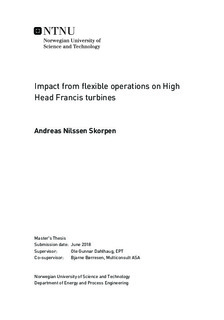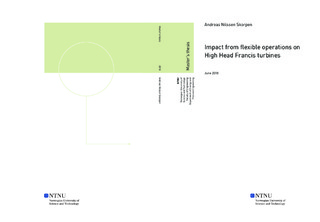| dc.description.abstract | Today the European energy grid contains more renewable energy sources than ever before, yet there is little to no research on how the increased amount affects the cost structure of the remaining energy sources of the grid. A consequence of phasing more renewable energy sources into the power grid, is a reduction of the overall balancing capacity of the grid. Thus, the demand for balancing services from the remaining dispatchable energy sources increases. Hydropower is currently frequently used to balance the grid, and thus, the increased demand for balancing services offers a large opportunity for the hydropower segment. Furthermore, as the operating patterns become increasingly aggressive, the structural integrity is reduced, and the maintenance costs are increased. This thesis finds and elucidates the magnitude of the reduced lifetime and increased maintenance costs.
This master s thesis finds that the reduction of the structural integrity comes at a large cost, and greatly impacts the overall financial feasibility. In that regard, it is presented market solutions that further incentives balancing services. Balancing services are in markets sold as system services, which includes frequency response, black start capacity, reactive power, and reserve capacity. The thesis presents operating patterns for Francis turbines that seek to fulfill the various system services.
The thesis predicts the lifetime of five unique operating patterns, one is assumingly the status quo of operations today, and another is an analogy of operating the turbine like a battery. The results show that low part load and startup are the most damaging operating points, and that the lifetime is lower for flexible operations, than the currently expected lifetime.
Despite greatly reducing the lifetime of the turbine, the evaluated cases are financially feasible if they are adequately rewarded. The exact power price that provides adequate rewards differs for all five cases. Financially feasible power prices are in the interval 0.257 to 0.0533 NOK/kWh, where the lowest price refer to current operations and the highest price refers to the aggressive extreme case.
The analyses conducted in this thesis are utilizing the numerical software ANSYS mechanical to predict the stress state, the Palmgren-Miner method to predict the lifetime, the rothalpy relationship to predict the pressure in the runner and net present value calculations to evaluate the financial feasibility. In addition, the thesis utilizes, and post-processes previously conducted numerical fluid analyses and pressure measurements from the Waterpower Laboratory at NTNU. | |

